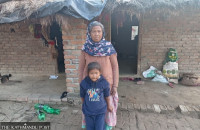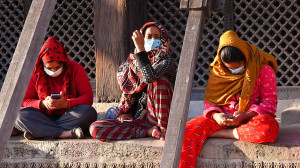National
Leopard attacks on the rise in Bardiya: Three dead, 11 injured since November
Conservationists say dwindling prey in forests is pushing leopards into human settlements.
Kamal Panthi
Leopard attacks in Bardiya district have intensified in recent months, leaving at least three people dead and 11 others injured since mid-November, according to local authorities and conservationists.
The most recent fatality occurred on April 28, when a nine-year-old girl, Melina Khadka, was killed by a leopard while collecting firewood with her aunt in Saryu Community Forest in ward 8 of Gulariya Municipality in the district. Melina, who was from ward 6 of Geruwa Rural Municipality came to visit her aunt at Gulariya.
Earlier, on April 12, 40-year-old Urmila Tharu was attacked while gathering timber in Jiraha Community Forest, Bardiya.
Injuries from leopard encounters are also mounting. On April 2, seven-year-old Sarjan Chaudhary from ward 5 of Gulariya was attacked while accompanying his grandmother in a maize field and is currently undergoing treatment in Nepalgunj.
On April 13, 64-year-old Bikhu Tharu in ward 4 of Gulariya was mauled while harvesting wheat. The other injured in the attacks include four-year-old Shivam Tharu, attacked on March 22 while playing in his yard in Madhuban–4, and several others across Madhuban, Rajapur, and Gulariya municipalities.
Bardiya Division Forest Office confirmed that three people have been killed and 11 injured since November last year. Five-year-old Rihan Chaudhary from ward 6 of Duduwa Rural Municipality who was mauled to death while playing in his yard in ward 9 of Ganga Basti, Madhuban, on February 7.
The same day, Junakumari Lamichhane Kshetri from ward 7 of Madhuban also succumbed to injuries following a leopard attack.
Forest officials blame the food scarcity in Bardiya National Park, buffer zones, and surrounding community forests for the increasing human-wildlife conflict leading to the deaths and injuries.
“As prey species decline and tigers dominate the forest, leopards are moving into human areas in search of food,” said Divisional Forest Officer Bijaya Raj Subedi.
A recent study also pointed to Indian forest authorities allegedly releasing problematic leopards from the Katarniaghat Wildlife Sanctuary—adjacent to Bardiya—into the wild, compounding the crisis.
“Leopards have increasingly been sighted in areas like Tepari in Gulariya due to their proximity to the Indian border,” locals report.
Bardiya National Park, which houses 125 tigers, has not conducted a proper census of its leopard population, making it harder to assess the scale of the issue. However, sightings and livestock killings have spiked. Locals in Tepari say leopards are not only attacking people but also killing domestic animals such as goats and dogs regularly.
In an effort to contain the wild animals, forest officials have installed cages baited with goats and deployed camera traps in fields in Gulariya–4. But no leopard has been captured so far.
In one notable area near the Blackbuck Conservation Zone, it is estimated that three to four leopards are responsible for killing over a dozen blackbucks each year.
“Food scarcity is the primary driver,” said Ashok Ram, chief of Bardiya National Park. “Until the declining number of prey species is recovered and corridors are protected, human-wildlife conflict will persist.”
Local fear continues to rise as leopards appear more frequently in villages bordering India. Residents and conservationists alike are urging cross-border cooperation and improved wildlife management to prevent further casualties.




 9.12°C Kathmandu
9.12°C Kathmandu













%20(1).jpg&w=300&height=200)

